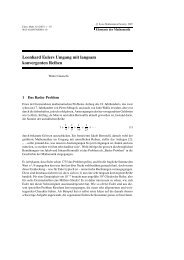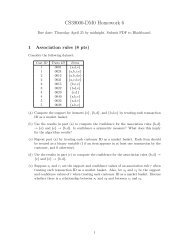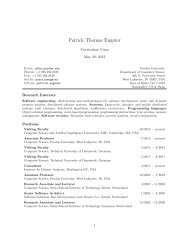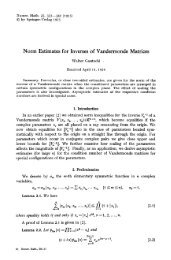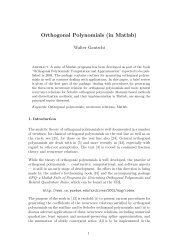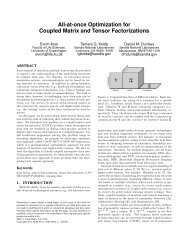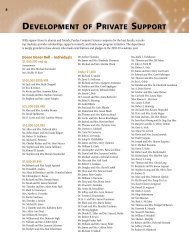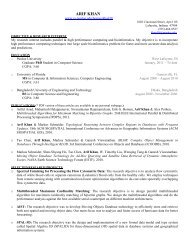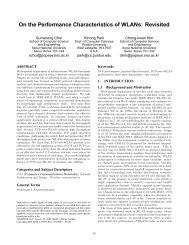CS 2003-2004 Faculty Information - Department of Computer ...
CS 2003-2004 Faculty Information - Department of Computer ...
CS 2003-2004 Faculty Information - Department of Computer ...
You also want an ePaper? Increase the reach of your titles
YUMPU automatically turns print PDFs into web optimized ePapers that Google loves.
2000). He also has published about 300 scientific articles. The most recent twenty-five or so articles were in the areas<br />
<strong>of</strong> agent-based computing, computational science, computer security, mathematical s<strong>of</strong>tware, problem solving environments,<br />
recommender systems, simulating gas turbines, and web-based computing.<br />
In addition to the projects appearing in the Research Funding section, Pr<strong>of</strong>essor Rice has received funding for these<br />
external projects: “Effectiveness <strong>of</strong> S<strong>of</strong>tware Projection Methods” (with Mike Atallah and Buster Dunsmore), Wright-<br />
Patterson Air Force Base, 11/1/02 - 11/1/03, $950,000; “Automatically Protecting S<strong>of</strong>tware Against ‘diff ’ Attacks” (with<br />
Mike Atallah and David M’Raihi), SBIR <strong>Department</strong> <strong>of</strong> Defense, 8/12/03 - 1/31/04, $250,000; and “Tools for<br />
Quantifying S<strong>of</strong>tware Vulnerabilities and Protection” (with Mike Atallah), Indiana 21st Century Fund, 4/1/04 - 4/1/05,<br />
$1,178,256.<br />
Elisha Sacks<br />
Education:<br />
BS, Mathematics and <strong>Computer</strong> Science, Carnegie-Mellou University, 1982<br />
S.M., <strong>Computer</strong> Science, Massachusetts Institute <strong>of</strong> Technology, 1985<br />
PhD, <strong>Computer</strong> Science, Massachusetts Institute <strong>of</strong> Technology, 1988<br />
Position:<br />
Pr<strong>of</strong>essor <strong>of</strong> <strong>Computer</strong> Science<br />
Bio-sketch:<br />
Dr. Sacks’s research area is geometric reasoning in science and engineering. He is a problem solver who couples domain<br />
knowledge, mathematics, and computer science to solve real-world problems. He worked on qualitative analysis <strong>of</strong><br />
nonlinear dynamical systems for his PhD and for the next few years. He has worked on mechanical design since then<br />
and plans to continue for a while. He is also working with Matt Mason <strong>of</strong> Carnegie Mellon University on robot path<br />
planning with obstacles and steering constraints and with Victor Milenkovic <strong>of</strong> University <strong>of</strong> Miami on robust computational<br />
geometry. His unique skill is in combining (<strong>of</strong>ten esoteric) mathematics with (<strong>of</strong>ten inarticulated) domain<br />
knowledge with (<strong>of</strong>ten idealized) computational methods to solve real-world problems.<br />
The mechanical design research addresses kinematic analysis and the related tasks <strong>of</strong> simulation, tolerancing, and<br />
parametric design. Kinematic analysis means computing the ways that mechanical parts interact: how gears mesh,<br />
how linkages transform motion, how robots grasp. Kinematic analysis is central to mechanical design because part<br />
contacts largely determine mechanical function and because other forms <strong>of</strong> analysis (dynamical simulation, stress, tolerance)<br />
presuppose it. Prior to his research, a general, practical kinematic analysis algorithm was deemed impossible.<br />
He has developed and implemented such an algorithm based on configuration space computation. He is working with<br />
academic and industrial collaborators to develop practical mechanical design s<strong>of</strong>tware based on his research, notably<br />
with Ford Motors on transmission design and with Sandia National laboratory on micro-mechanism design. Dr. Sacks<br />
is also the director <strong>of</strong> the Visualization Center.<br />
Selected Publications:<br />
Min-Ho Kyung and Elisha Sacks, “Parameter Synthesis <strong>of</strong> Higher Kinematic Pairs,” <strong>Computer</strong>-Aided Design,Volume<br />
35, No. 1, <strong>2003</strong>.<br />
Elisha Sacks, “Path Planning for Planar Articulated Robots using Configuration Spaces and Compliant Motion,”<br />
IEEE Transactions on Robotics and Automation, Volume 19, No. 3, <strong>2003</strong>.<br />
Voicu Popescu, Elisha Sacks, and Gleb Bahmutov, “The ModelCamera: A Hand-Held Device for Interactive<br />
Modeling,” Proceedings <strong>of</strong> the Fourth International Conference on Digital Imaging and Modeling, Banff, <strong>2003</strong>.<br />
37



